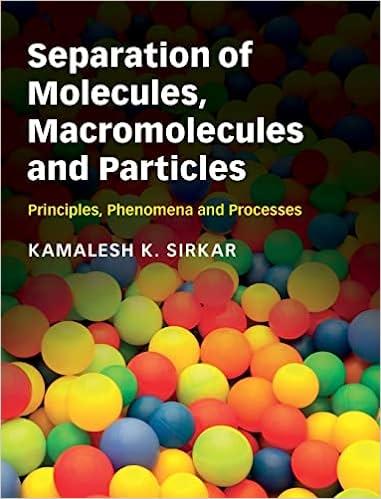Answered step by step
Verified Expert Solution
Question
1 Approved Answer
Topic: A set of Algebraic Equations with multiple variables Application: Steady - state balance in a steam reforming plant Problem Statement: Steam reforming of methane
Topic: A set of Algebraic Equations with multiple variables
Application: Steadystate balance in a steam reforming plant
Problem Statement:
Steam reforming of methane is one way to produce clean hydrogen for the 'Hydrogen economy'. The main two reactions are given below:
Rxn
A steam reforming of methane reactor takes in and The output stream of the reactor is a mixture of unreacted and and the products and The composition out of the reformer is based mainly on chemical equilibrium. Given the temperature, the pressure, and the composition of the inlet stream, we want to know what the composition of the outlet stream at equilibrium steady state
Figure : Schematic diagram showing a reactor, which takes and as the input streams and produces and The exit of the reactor contains also unreacted and
The reactor is well mixed, implying that the concentration of species at the exit of the reactor under steady state corresponds to the concentration in equilibrium inside the reactor.
To solve this problem we can use the method of minimum reactions.
The mole rate of carbon, oxygen and hydrogen entering the reactor can be deduced based on the input flows and The mass balance for the total carbon, hydrogen and oxygen can be written in the following way:
Under steady state, the molar flow of reactants and products inside the reactor will be constant. An elemental mass balance on carbon, hydrogen and oxygen elements using the molar flow under stated state can be expressed in the following way:
Where are the mole rates at the exit of the reactor. The set of three reactions given by EqEq contains five unknown parameters. We require two additional equations in order to be able to find a unique solution to the concentration. The extra two equations can be related to the equilibrium constant for each reaction. The equilibrium equation for Rxn can be expressed in the following way:
Where is the pressure of the system, is the standard pressure and is the total number of moles inside the reactor; calculated as the sum of all species present in reaction Rxn
The equilibrium equation for can be expressed in the following way:
The equilibrium constants and can be calculated using the following polynomial expressions:
exp
Where
with being the temperature of the reaction
Calculate the concentration of all the species at the exit of the reactor under steady state, for a known flow of and entering the reactor. Write a Matlab program that determines the equilibrium composition under a steady state in the methane steam reforming. Plot the flow of and at the exit of the reactor as a function of temperature in the range of to The pressure of the reactor is always atm and the input flow of methane is mole while that of steam is mole
Just for your reference, the concentration of at the exit of the reactor as a function of temperature looks like:
I also meed to reproduce a plot of CH exit comcentraion vs temperature

Step by Step Solution
There are 3 Steps involved in it
Step: 1

Get Instant Access to Expert-Tailored Solutions
See step-by-step solutions with expert insights and AI powered tools for academic success
Step: 2

Step: 3

Ace Your Homework with AI
Get the answers you need in no time with our AI-driven, step-by-step assistance
Get Started


